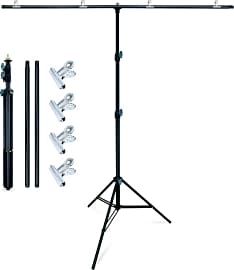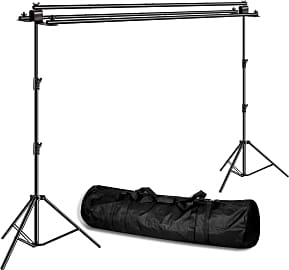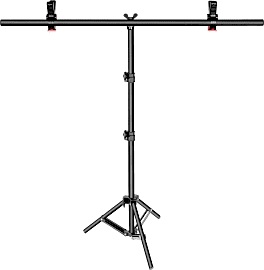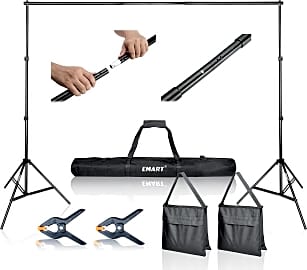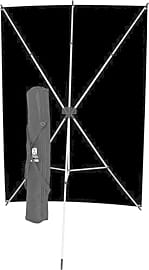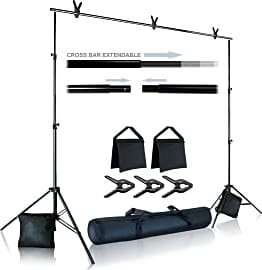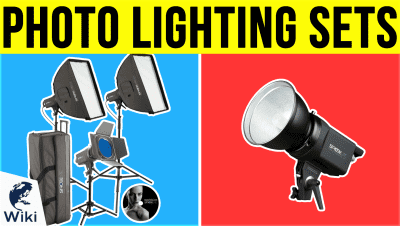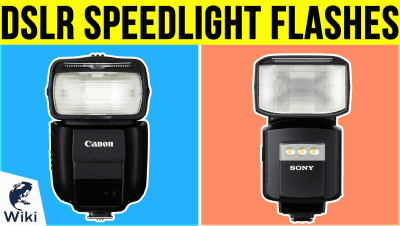The 10 Best Backdrop Stands

This wiki has been updated 33 times since it was first published in December of 2016. If you want to avoid hanging hooks from the ceiling for your home photo shoot or projecting movies onto a "sort-of white" wall, consider investing a modest sum in one of these backdrop stands. Offering easy portability and a fast setup and breakdown, they are well suited to product photography, green screen videos, and more. We've included options for casual users as well as professionals. When users buy our independently chosen editorial picks, we may earn commissions to help fund the Wiki.
Editor's Notes
October 19, 2020:
New to the list, the Emart Triple can be used to hang three backdrops at once, which is helpful both for switching between different screens quickly during a photoshoot and for creating multi-level displays for trade shows, parties, or weddings. We also added a t-shaped model to the list, giving vloggers and remote workers a compact option. The Neewer T-Shape is a sturdy choice that's easy to use and is ideal for filming or photographing a single person.
Height and width are important factors to keep in mind when choosing a backdrop stand. If you need to set up in a small space, then a more compact model like the Linco Zenith or Westcott X-Drop can be helpful. However, if you need good coverage for multi-person film or photo shoots, then you want to make sure to go with something bigger like the LimoStudio Support Structure. Many options are adjustable, making them versatile choices for people who work on multiple projects.
Some models just come with the stand, while others include accessories such as clamps, carrying cases, or sandbags. If you already have this equipment, you might want to stick to an option that only includes what you need. But if you're starting out, a comprehensive kit can be a good value.
July 10, 2019:
At this time, we've decided to remove the Ravelli ABSL and StudioFX PHOT-12 due to availability issues, but we still like the LimoStudio Support Structure and the Savage Port-A-Stand. The former is best for those with casual needs or those who don't have a large budget, while the latter is a good choice for professionals looking for reliability. We also added the Polaroid Pro Studio as an in-between option; its construction is robust enough for the serious photographer who's building a business — but who may not have a big gear budget just yet, especially after investing in a quality DSLR camera.
We selected two highly portable models, as well: the Linco Zenith and the Westcott X-Drop. Keep in mind that these are not as stable as their larger, heavier counterparts, which means they won't be the best in wind or on rough terrain. They make up for this by being light and easy to carry, so if you don't have an assistant to help you, or you'll be setting up in a tight space, they may just do the trick.
Special Honors
Manfrotto Complete For professionals who rely on their gear to be sturdy and practical, the Manfrotto Complete is an ideal solution. It was made for fabric and roll backgrounds and is surprisingly lightweight, given how sturdy it feels. It is something of an investment, however. manfrotto.com
Photoflex ProDuty If you need something big and sturdy, you could do far worse than the Photoflex ProDuty. Extending to over 12 feet, the telescoping backdrop pole collapses to just under 5 feet for storage, without any struggle or hassle. photoflex.com
Looking Professional (And Charging For It)
A customer who’s impressed by everything from your studio space to your demeanor and, of course, your final product is more likely to refer you to a colleague.
There’s a common problem among photographers who are just starting to charge for their services. It arises when a given shooter has to figure out what to charge for their work, and rates can vary wildly depending on the specific type of pictures you shoot and the city in which you live. A talented product photographer in Oklahoma may only charge a small fee for a large spread of images, where a hack of a headshot photographer in LA can demand hundreds for just a few hours of work.
If you’re among the more talented photographers in your pocket of industry, you might also run into a problem of perception. You could try to undercut the competition by charging less, but some potential clients might be wary of anyone who isn’t asking for as much as the other guys. You could market yourself as an upscale option and try to syphon off customers from other shooters by creating an air of exclusivity, but then you really need to back up your rates. If you overcharge a client and they show up to a rundown garage with a bed sheet hanging from a fishing rod, they’re going to know something’s up.
However much you end up charging for your services, looking the part of the professional will only increase your bottom line. A customer who’s impressed by everything from your studio space to your demeanor and, of course, your final product is more likely to refer you to a colleague. And like many artistic commercial endeavors, word of mouth is vital.
One of the best investments you can make in improving the professional look of both your studio and your photographs is a high-quality backdrop stand. With a good stand, you can hang any number of colors or materials behind your subjects, allowing you greater control over the appearance of the background in your shots, as well as your overall lighting effects.
Another great reason to invest in a stand is for the safety of your workspace. If you use a makeshift stand cobbled together from parts at the hardware store, you’re more likely to see your backdrop — whether it’s muslin or a paper roll — fall down at some point. If it hits a product you’re shooting, you’re going to have to ask the company for a replacement, which will most likely come out of your fee. If it hits a person you're shooting and does any kind of damage, you’re looking at the potential for a career-ending lawsuit.
A backdrop stand will prevent such maladies by securing your materials in place. It's also liable to be much more adjustable than something you rig up yourself, meaning you can increase the types of photographs you shoot. Most stands are also pretty portable, so you can take your studio out with you if you need to.
How To Choose The Right Backdrop Stand For You
For the most part, backdrop stands all look pretty much alike. They feature two side supports that are more often than not light stands in and of themselves, as well as a top bar that runs an adjustable length between the two stands. When it comes time to figure out which stand is right for you, then, you’ll have to look at what it is you intend to shoot, and what small features might mean a lot to you.
Still, most stands that can support a 107-inch backdrop can compress to hang the smaller option, as well.
The available length of that top bar is the first thing you should look at. Most muslin backdrops and paper rolls come in one of two popular widths: 53 and 107 inches. If you only shoot people one at a time, or you work with smaller products, you can easily get away with a stand the only accommodates 53-inch backdrops. Still, most stands that can support a 107-inch backdrop can compress to hang the smaller option, as well.
If you’re thinking about going with something smaller because your current studio space is on the cramped side, it might actually be smarter to get a larger, adjustable model that you can use in a bigger studio if and when you upgrade. Obviously, if you need your stand to get as wide as possible, then look for a stand with a long top bar.
A good feature to look out for is some kind of bar lock. These usually look a lot like wingnuts, and they’re used to secure the top bar to the side supports. If you need to move your stand around in your space, even to make small adjustment, this can be a lifesaver, as it will keep your top bar from coming dislodged and hurting anyone.
There are models on the market that feature multiple top bars, as well, and these allow you to install a few different paper rolls at once, giving you the ability to quickly switch from one background to another.
Outfitting Your Professional Studio
Once you’ve decided which backdrop stand is the perfect fit for your studio, there are a few other essential investments you can make that will take your brand to the next level. Some will improve the quality of your photos, while others will make you a photographer that people want to work with.
As far as your clients are concerned, your professionalism goes far beyond just the images you turn in.
On the photographic side, you’ll want to make sure you’ve got a great set of lights, whether we’re talking a set of strobes or speedlights designed for your specific brand of camera. These will help you create the kind of three-point lighting you need for a good portrait. Another indispensable item is a light meter. While many cameras have some version of a light meter built in, using the real thing will ensure you have total control over your exposure.
As far as your clients are concerned, your professionalism goes far beyond just the images you turn in. You want your space to be as accommodating as possible when taking meetings and pictures alike. That’s why it’s important to invest in safety features around your studio like sandbags and work lights. That’s also why it’s a good idea to outfit your space with things like a mini fridge to store drinks (and film, if anyone still shoots film).




